Fe
Abstract
1. Introduction
2. Computational Calculation Methodology
3. Results and Discussions
3.1. Bonding, Wiberg Bond Indices, and Molecular Orbital Analysis
3.2. Adaptive Natural Density Partitioning (AdNDP) Analysis
3.3. Topological Analysis: Electron Localization Function and Laplacian of Electron Density
3.4. IR and Raman Spectra
4. Conclusions
Supplementary Materials
Author Contributions
Funding
Institutional Review Board Statement
Informed Consent Statement
Data Availability Statement
Acknowledgments
Conflicts of Interest
References
- Miralrio, A.; Hernández-Hernández, A.; Pescador-Rojas, J.A.; Sansores, E.; López-Pérez, P.A.; Martínez-Farías, F.; Cortes, E.R. Theoretical Study of the Stability and Properties of Magic Numbers (m = 5, n = 2) and (m = 6, n = 3) of Bimetallic Bismuth-Copper Nanoclusters; Bim Cun. Int. J. Quantum Chem. 2017, 117, e25449. [Google Scholar] [CrossRef]
- Billas, I.M.L.; De Heer, W.A.; Chatelain, A. Magnetic Properties of Small Iron Systems: From Ferromagnetic Resonance of Precipitated Particles in Silica to Stern-Gerlach Deflections in Molecular Beam. J. Non Cryst. Solids 1994, 179, 316–323. [Google Scholar] [CrossRef]
- Castro, M. The role of the Jahn-teller distortions on the structural, binding, and magnetic properties of small Fen clusters, n ≤ 7. Int. J. Quantum Chem. 1997, 64, 223–230. [Google Scholar] [CrossRef]
- Fehlner, T.; Halet, J.F.; Saillard, J.Y. Molecular Clusters: A Bridge to Solid-State Chemistry; Cambridge University Press: Cambridge, UK, 2007. [Google Scholar]
- Li, H.-F.; Li, Z.-Y.; Liu, Q.-Y.; Li, X.-N.; Zhao, Y.-X.; He, S.-G. Methane Activation by Iron-Carbide Cluster Anions FeC6−. J. Phys. Chem. Lett. 2015, 6, 2287–2291. [Google Scholar] [CrossRef] [PubMed]
- Allen, M.D.; Pesch, T.C.; Ziurys, L.M. The pure rotational spectrum of FeC (X3Δi). Astrophys. J. 1996, 472, L57. [Google Scholar] [CrossRef][Green Version]
- Chu, C.J.; Kafafi, Z.H.; Margrave, J.L.; Hauge, R.H.; Billups, W.E. Matrix-Isolation Studies of the Reactions of Ground- and Excited-State Atomic Iron with Cyclopropane. Organometallics 2000, 19, 39–48. [Google Scholar] [CrossRef]
- Balfour, W.J.; Cao, J.; Prasad, C.V.V.; Qian, C.X.W. Electronic Spectroscopy of Jet-Cooled Iron Monocarbide. The 3Δi←3Δi Transition near 493 nm. J. Chem Phys. 1995, 103, 4046–4051. [Google Scholar] [CrossRef]
- Tzeli, D.; Mavridis, A. Accurate Ab Initio Calculations of the Ground States of FeC, FeC+, and FeC−. J. Chem. Phys. 2010, 132, 194312. [Google Scholar] [CrossRef]
- Tzeli, D.; Mavridis, A. Theoretical Investigation of Iron Carbide, FeC. J. Chem. Phys. 2002, 116, 4901–4921. [Google Scholar] [CrossRef][Green Version]
- Li, C.G.; Zhang, J.; Zhang, W.Q.; Tang, Y.N.; Ren, B.Z.; Hu, Y.F. First-Principle Study of Structural, Electronic and Magnetic Properties of (FeC)n (n = 1–8) and (FeC)8TM (TM = V, Cr, Mn and Co) Clusters. Sci. Rep. 2017, 7, 17516. [Google Scholar] [CrossRef]
- Steglich, M.; Chen, X.; Johnson, A.; Maier, J.P. UV Spectra of Iron-Doped Carbon Clusters FeCn n = 3–6. Int. J. Mass Spectrom. 2014, 365–366, 351–355. [Google Scholar] [CrossRef][Green Version]
- Huisken, F.; Kohn, B.; Alexandrescu, R.; Morjan, I. Reactions of Iron Clusters with Oxygen and Ethylene: Observation of Particularly Stable Species. J. Chem. Phys. 2000, 113, 6579–6584. [Google Scholar] [CrossRef]
- Ball, D.W.; Pong, R.G.S.; Kafafi’, Z.H. Reactions of Atomic and Diatomic Iron with Allene in Solid Argon. J. Am. Chem. Soc. 1993, 115, 2864–2870. [Google Scholar] [CrossRef]
- Glukhovtsev, M.N.; Bach, R.D.; Nagel, C.J. Performance of the B3LYP/ECP DFT Calculations of Iron-Containing Compounds. J. Phys. Chem. A 1997, 101, 316–323. [Google Scholar] [CrossRef]
- Pilgrim, J.S.; Duncan, M.A. Metallo-Carbohedrenes: Chromium, Iron, and Molybdenum Analogs. J. Am. Chem. Soc. 1993, 115, 6958–6961. [Google Scholar] [CrossRef]
- Nash, B.K.; Rao, B.K.; Jena, P. Equilibrium Structure and Bonding of Small Iron-Carbon Clusters. J. Chem. Phys. 1996, 105, 11020–11023. [Google Scholar] [CrossRef][Green Version]
- Noya, E.G.; Longo, R.C.; Gallego, L.J. Geometric Structure and Electronic Properties of Neutral and Anionic Fe2C3 and Fe2C4 Clusters, as Obtained by Density-Functional Calculations. J. Chem. Phys. 2004, 120, 2069–2070. [Google Scholar] [CrossRef]
- Noya, E.G.; Longo, R.C.; Gallego, L.J. Density-Functional Calculations of the Structures, Binding Energies, and Spin Multiplicities of Fe-C Clusters. J. Chem. Phys. 2003, 119, 11130–11134. [Google Scholar] [CrossRef]
- Largo, L.; Barrientos, C.; Redondo, P. Small Iron Doped Carbon Clusters: A Comparison with Early and Late First-Row Transition Metal Doped Clusters. J. Chem. Phys. 2009, 130, 134304. [Google Scholar] [CrossRef]
- Zhang, B.; Cao, B.B.; Chen, C.; Zhang, J.; Duan, H.M. Density-Functional Theory Study on Neutral and Charged MnC2 (M = Fe, Co, Ni, Cu; n = 1–5) Clusters. J. Clust. Sci. 2013, 24, 197–207. [Google Scholar] [CrossRef]
- Limon, P.; Miralrio, A.; Castro, M. Characterization of Magnetic Series of Iron-Carbon Clusters FeNC0, ±1 (n ≤ 13). J. Phys. Chem. C 2020, 124, 9484–9495. [Google Scholar] [CrossRef]
- Zhang, Z.X.; Cao, B.B.; Duan, H.M. Density-Functional Calculations of MnC(M = Fe, Co, Ni, Cu, n = 1–6) Clusters. J. Mol. Struct. Theochem 2008, 863, 22–27. [Google Scholar] [CrossRef]
- Wang, L.-S.; Li, X. Vibrationally Resolved Photoelectron Spectroscopy of the First Row Transition Metal and C3 Clusters: MC3− (M=Sc, V, Cr, Mn, Fe, Co, and Ni). J. Chem. Phys. 2000, 112, 3602–3608. [Google Scholar] [CrossRef]
- Lebrilla, C.B.; Drewello, T.; Schwarz, H. Formation and Detection of Neutral FeCHx (x = 0–3) Using Neutralization-Reionization Mass Spectrometry (NRMS). Organometallics. 1987, 6, 2268–2270. [Google Scholar] [CrossRef]
- Fan, J.; Wang, L.-S. A Study of FeC2 and FeC2H by Anion Photoelectron Spectroscopy. J. Phys. Chem. 1994, 98, 11814–11817. [Google Scholar] [CrossRef]
- Husband, J.; Aguirre, F.; Thompson, C.J.; Laperle, C.M.; Metz, R.B. Photofragment Spectroscopy of FeCH2+, CoCH2+, and NiCH2+ near the M+-CH2 Dissociation Threshold. J. Phys. Chem. A 2000, 104, 2020–2024. [Google Scholar] [CrossRef]
- Drechsler, G.; Boesl, U. Mass Selective Photodetachment Photoelectron Spectroscopy: Small Transition Metal (Fe, Ni) Carbon Hydrogen Compounds. Int. J. Mass Spectrom. 2003, 228, 1067–1082. [Google Scholar] [CrossRef]
- Chang, C.; Patzer, A.B.C.; Kegel, W.H.; Chandra, S. Small Fe Bearing Ring Molecules of Possible Astrophysical Interest: Molecular Properties and Rotational Spectra. Astrophys. Space Sci. 2013, 347, 315–325. [Google Scholar] [CrossRef]
- Guo, B.C.; Kerns, K.P.; Castleman, A.W., Jr. Ti8C12+-metallo-carbohedrenes: A New Class of Molecular Clusters? Science 1992, 255, 1411–1413. [Google Scholar] [CrossRef]
- Ryzhkov, M.V.; Delley, B. Geometry, electronic structure, and magnetic ordering of iron-carbon nanoparticles. Theor. Chem. Acc. 2012, 131, 1144. [Google Scholar] [CrossRef]
- Ryzhkov, M.V.; Ivanovskii, A.L.; Delley, B.T. Electronic Structure and Geometry Optimization of Nanoparticles Fe2C, FeC2, Fe3C, FeC3 and Fe2C2. Chem Phys Lett. 2005, 404, 400–408. [Google Scholar] [CrossRef]
- Hensley, B.S.; Draine, B.T. Thermodynamics and charging of interstellar iron nanoparticles. Astrophys. J. 2017, 834, 134. [Google Scholar] [CrossRef]
- Rohmer, M.M.; Bénard, M.; Poblet, J.-M. Structure, Reactivity, and Growth Pathways of Metallocarbohedrenes M8C12 and Transition Metal/Carbon Clusters and Nanocrystals: A Challenge to Computational Chemistry. Chem. Rev. 2000, 100, 495–542. [Google Scholar] [CrossRef]
- Geng, C.; Li, J.; Weiske, T.; Schwarz, H. A Reaction-Induced Localization of Spin Density Enables Thermal C−H Bond Activation of Methane by Pristine FeC4+. Chem. A Eur. J. 2019, 25, 12940–12945. [Google Scholar] [CrossRef]
- Hu, Y.; Jensen, J.O.; Zhang, W.; Cleemann, L.N.; Xing, W.; Bjerrum, N.J.; Li, Q. Hollow Spheres of Iron Carbide Nanoparticles Encased in Graphitic Layers as Oxygen Reduction Catalysts. Angew. Chem. Int. Ed. 2014, 53, 3675–3679. [Google Scholar] [CrossRef]
- Li, S.; Yang, J.; Song, C.; Zhu, Q.; Xiao, D.; Ma, D. Iron Carbides: Control Synthesis and Catalytic Applications in COx Hydrogenation and Electrochemical HER. Adv. Mater. 2019, 31, e1901796. [Google Scholar] [CrossRef]
- Wang, X.; Zhu, K.; Ju, Y.; Li, Y.; Li, W.; Xu, J.; Hou, Y. Iron Carbides: Magic Materials with Magnetic and Catalytic Properties. J. Magn. Magn. Mater. 2019, 489, 165432. [Google Scholar] [CrossRef]
- Li, Y.; Li, Z.; Ahsen, A.; Lammich, L.; Mannie, G.J.A.; Niemantsverdriet, J.W.H.; Lauritsen, J.V. Atomically Defined Iron Carbide Surface for Fischer-Tropsch Synthesis Catalysis. ACS Catal. 2019, 9, 1264–1273. [Google Scholar] [CrossRef]
- Miyaoka, H.; Ichikawa, T.; Fujii, T.; Ishida, W.; Isobe, S.; Fuji, H.; Kojima, Y. Anomalous Hydrogen Absorption on Non-Stoichiometric Iron-Carbon Compound. J. Alloys Compd. 2010, 507, 547–550. [Google Scholar] [CrossRef]
- Wu, X.; Dong, J.; Qiu, M.; Li, Y.; Zhang, Y.; Zhang, H.; Zhang, J. Subnanometer Iron Clusters Confined in a Porous Carbon Matrix for Highly Efficient Zinc-Air Batteries. Nanoscale Horiz. 2020, 5, 359–365. [Google Scholar] [CrossRef]
- Fan, D.; Chen, C.; Lu, S.; Li, X.; Jiang, M.; Hu, X. Highly Stable Two-Dimensional Iron Monocarbide with Planar Hypercoordinate Moiety and Superior Li-Ion Storage Performance. ACS Appl. Mater. Interfaces. 2020, 12, 30297–30303. [Google Scholar] [CrossRef]
- Xiang, T.; Chen, Z.; Rao, Z.; Yan, M.; Feng, Z.; Li, X.; Yang, H.; Huang, J.; Shen, X. Hierarchical Fe/Fe3C/C Nanofibers as Anodes for High Capacity and Rate in Lithium Ion Batteries. Ionics 2021, 27, 3663–3669. [Google Scholar] [CrossRef]
- Monkhorst, H.J. Activation Energy for Interconversion of Enantiomers Containing an Asymmetric Carbon Atom without Breaking Bonds. Chem. Commun. 1968, 18, 1111–1112. [Google Scholar] [CrossRef]
- Erker, G. Planar-Tetracoordinate Carbon: Making Stable Anti-van’t Hoff/LeBel Compounds. Comments Inorg. Chem. 1992, 13, 111–131. [Google Scholar] [CrossRef]
- Hoffmann, R.; Alder, R.W.; Wilcox, C.F., Jr. Planar tetracoordinate carbon. J. Am. Chem. Soc. 1970, 92, 4992–4993. [Google Scholar] [CrossRef]
- Ravell, E.; Jalife, S.; Barroso, J.; Orozco-Ic, M.; Hernández-Juárez, G.; Ortiz-Chi, F.; Pan, S.; Cabellos, J.L.; Merino, G. Structure and Bonding in CE5−(E=Al-Tl) Clusters: Planar Tetracoordinate Carbon versus Pentacoordinate Carbon. Chem. Asian J. 2018, 13, 1467–1473. [Google Scholar] [CrossRef]
- Sarkar, P.; Thirumoorthy, K.; Anoop, A.; Thimmakondu, V.S. Planar Pentacoordinate Carbon in [XC7H2]2+ (X = Be and Mg) and Its Derivatives. Phys. Chem. Chem. Phys. 2022, 24, 27606–27611. [Google Scholar] [CrossRef]
- Leyva-Parra, L.; Diego, L.; Yañez, O.; Inostroza, D.; Barroso, J.; Vásquez-Espinal, A.; Merino, G.; Tiznado, W. Planar Hexacoordinate Carbons: Half Covalent, Half Ionic. Angew. Chem. Int. Ed. 2021, 60, 8700–8704. [Google Scholar] [CrossRef]
- Jimenez-Halla, J.O.C.; Wu, Y.-B.; Wang, Z.-X.; Islas, R.; Heine, T.; Merino, G. CAl4Be and CAl3Be2-: Global Minima with a Planar Pentacoordinate Carbon Atom. Chem. Commun. 2010, 46, 8776–8778. [Google Scholar] [CrossRef] [PubMed]
- Yañez, O.; Báez-Grez, R.; Garza, J.; Pan, S.; Barroso, J.; Vásquez-Espinal, A.; Merino, G.; Tiznado, W. Embedding a Planar Hypercoordinate Carbon Atom into a [4n+2] π-System. ChemPhysChem 2020, 21, 145–148. [Google Scholar] [CrossRef]
- Wang, L.-M.; Huang, W.; Averkiev, B.B.; Boldyrev, A.I.; Wang, L.-S. CB7-: Experimental and Theoretical Evidence against Hypercoordinate Planar Carbon. Angew. Chem. Int. Ed. 2007, 46, 4550–4553. [Google Scholar] [CrossRef]
- Malhan, A.H.; Thimmakondu, V.S.; Thirumoorthy, K. Five Bonds to Carbon through Tri-Coordination in Al3C3−/0. Chemistry 2023, 5, 1113–1123. [Google Scholar] [CrossRef]
- Malhan, A.H.; Thirumoorthy, K. Global minimum and a heap of low-lying isomers with planar tetracoordinate carbon in CAl3MgH2-system. Phys. Chem. Chem. Phys. 2024, 26, 3804–3809. [Google Scholar] [CrossRef]
- Cui, Z.-H.; Contreras, M.; Ding, Y.-H.; Merino, G. Planar Tetracoordinate Carbon versus Planar Tetracoordinate Boron: The Case of CB4 and Its Cation. J. Am. Chem. Soc. 2011, 133, 13228–13231. [Google Scholar] [CrossRef] [PubMed]
- Collins, J.B.; Dill, J.D.; Jemmis, E.D.; Apeloig, Y.; Schleyer, P.V.R.; Seeger, R.; Pople, J.A. Stabilization of planar tetracoordinate carbon. J. Am. Chem. Soc. 1976, 98, 5419–5427. [Google Scholar] [CrossRef]
- Thimmakondu, V.S.; Thirumoorthy, K. Si3C2H2 Isomers with a Planar Tetracoordinate Carbon or Silicon Atom(s). Comput. Theor. Chem. 2019, 1157, 40–46. [Google Scholar] [CrossRef]
- Das, P.; Khatun, M.; Anoop, A.; Chattaraj, P.K. CSinGe4−n2+ (n = 1–3): Prospective Systems Containing Planar Tetracoordinate Carbon (ptC). Phys. Chem. Chem. Phys. 2022, 24, 16701–16711. [Google Scholar] [CrossRef]
- Bai, L.-X.; Barroso, J.; Orozco-Ic, M.; Ortiz-Chi, F.; Guo, J.-C.; Merino, G. CAl11−: A Molecular Rotor with a Quasi-Planar Tetracoordinate Carbon. Chem. Commun. 2023, 59, 4966–4969. [Google Scholar] [CrossRef]
- Malhan, A.H.; Sobinson, S.; Job, N.; Shajan, S.; Mohanty, S.P.; Thimmakondu, V.S.; Thirumoorthy, K. Al2C4H2 Isomers with the Planar Tetracoordinate Carbon (PtC)/Aluminum (PtAl). Atoms 2022, 10, 112. [Google Scholar] [CrossRef]
- Job, N.; Khatun, M.; Thirumoorthy, K.; Sasanka Sankhar Reddy, C.H.; Chandrasekaran, V.; Anoop, A.; Thimmakondu, V.S. Cal4mg0/−: Global Minima with a Planar Tetracoordinate Carbon Atom. Atoms 2021, 9, 24. [Google Scholar] [CrossRef]
- Thirumoorthy, K.; Chandrasekaran, V.; Cooksy, A.L.; Thimmakondu, V.S. Kinetic Stability of Si2C5H2 Isomer with a Planar Tetracoordinate Carbon Atom. Chemistry 2020, 3, 13–27. [Google Scholar] [CrossRef]
- Xu, J.; Zhang, X.; Yu, S.; Ding, Y.-H.; Bowen, K.H. Identifying the Hydrogenated Planar Tetracoordinate Carbon: A Combined Experimental and Theoretical Study of CAl4H and CAl4H−. J. Phys. Chem. Lett. 2017, 8, 2263–2267. [Google Scholar] [CrossRef] [PubMed]
- Ebner, F.; Greb, L. Calix[4]Pyrrole Hydridosilicate: The Elusive Planar Tetracoordinate Silicon Imparts Striking Stability to Its Anionic Silicon Hydride. J. Am. Chem. Soc. 2018, 140, 17409–17412. [Google Scholar] [CrossRef] [PubMed]
- Li, X.; Wang, L.-S.; Boldyrev, A.I.; Simons, J. Tetracoordinated Planar Carbon in the Al4C- Anion. A Combined Photoelectron Spectroscopy and Ab Initio Study. J. Am. Chem. Soc. 1999, 121, 6033–6038. [Google Scholar] [CrossRef]
- Lein, M.; Frunzke, J.; Frenking, G. A Novel Class of Aromatic Compounds: Metal-Centered Planar Cations [Fe(Sb5)]+ and [Fe(Bi5)]+. Angew. Chem. Int. Ed. 2003, 42, 1303–1306. [Google Scholar] [CrossRef]
- Tanaka, H.; Neukermans, S.; Janssens, E.; Silverans, R.E.; Lievens, P. σ Aromaticity of the Bimetallic Au5Zn+ Cluster. J. Am. Chem. Soc. 2003, 125, 2862–2863. [Google Scholar] [CrossRef]
- Neukermans, S.; Janssens, E.; Tanaka, H.; Silverans, R.E.; Lievens, P. Element- and Size-Dependent Electron Delocalization in AuNX+ Clusters (X = Sc, Ti, V, Cr, Mn, Fe, Co, Ni). Phys. Rev. Lett. 2003, 90, 033401. [Google Scholar] [CrossRef]
- Janssens, E.; Tanaka, H.; Neukermans, S.; Silverans, R.E.; Lievens, P. Electron Delocalization in AuNXM (X=Sc, Ti, Cr, Fe) Clusters: A Density Functional Theory and Photofragmentation Study. Phys. Rev. B 2004, 69, 085402. [Google Scholar] [CrossRef]
- Hou, X.-J.; Janssens, E.; Lievens, P.; Nguyen, M.T. Theoretical Study of the Geometric and Electronic Structure of Neutral and Anionic Doped Silver Clusters, Ag5X0,− with X = Sc, Ti, V, Cr, Mn, Fe, Co, and Ni. J. Chem. Phys. 2006, 330, 365–379. [Google Scholar] [CrossRef]
- Janssens, E.; Hou, X.J.; Nguyen, M.T.; Lievens, P. The Geometric, Electronic, and Magnetic Properties of Ag5X + (X=Sc, Ti, V, Cr, Mn, Fe, Co, and Ni) Clusters. J. Chem. Phys. 2006, 124, 184319. [Google Scholar] [CrossRef]
- Li, X.; Kiran, B.; Cui, L.-F.; Wang, L.-S. Magnetic Properties in Transition-Metal-Doped Gold Clusters: M@Au6 (M = Ti, V, Cr). Phys. Rev. Lett. 2005, 95, 253401. [Google Scholar] [CrossRef]
- Zhang, M.; He, L.-M.; Zhao, L.-X.; Feng, X.-J.; Luo, Y.-H. Tuning Magnetic Moments by 3d Transition-Metal-Doped Au6 Clusters. J. Phys. Chem. C 2009, 113, 6491–6496. [Google Scholar] [CrossRef]
- Höltzl, T.; Janssens, E.; Veldeman, N.; Veszprémi, T.; Lievens, P.; Nguyen, M.T. The Cu7Sc Cluster Is a Stable σ-Aromatic Seven-Membered Ring. ChemPhysChem. 2008, 9, 833–838. [Google Scholar] [CrossRef]
- Pu, Z.; Ito, K.; Schleyer, P.V.R.; Li, Q.-S. Planar Hepta-, Octa-, Nona-, and Decacoordinate First Row d-Block Metals Enclosed by Boron Rings. Inorg. Chem. 2009, 48, 10679–10686. [Google Scholar] [CrossRef] [PubMed]
- Ito, K.; Pu, Z.; Li, Q.-S.; Schleyer, P.V.R. Cyclic Boron Clusters Enclosing Planar Hypercoordinate Cobalt, Iron, and Nickel. Inorg. Chem. 2008, 47, 10906–10910. [Google Scholar] [CrossRef]
- Romanescu, C.; Galeev, T.R.; Sergeeva, A.P.; Li, W.-L.; Wang, L.-S.; Boldyrev, A.I. Experimental and Computational Evidence of Octa- and Nona-Coordinated Planar Iron-Doped Boron Clusters: Fe©B8- and Fe©B9-. J. Organomet. Chem. 2012, 721–722, 148–154. [Google Scholar] [CrossRef]
- Zhang, H.; Li, Y.; Hou, J.; Tu, K.; Chen, Z. FeB6 Monolayers: The Graphene-like Material with Hypercoordinate Transition Metal. J. Am. Chem. Soc. 2016, 138, 5644–5651. [Google Scholar] [CrossRef]
- Zhao, Y.; Liu, Q.; Xing, J.; Jiang, X.; Zhao, J. FeSi2: A Two-Dimensional Ferromagnet Containing Planar Hexacoordinate Fe Atoms. Nanoscale Adv. 2022, 4, 600–607. [Google Scholar] [CrossRef] [PubMed]
- Shajan, S.; Guo, J.-C.; Sinjari, A.; Thirumoorthy, K.; Thimmakondu, V.S. Pentacoordinate Carbon Atoms in a Ferrocene Dication Derivative—[Fe(Si2-η5-C5H2)2]2+. Chemistry 2022, 4, 1092–1100. [Google Scholar] [CrossRef]
- Kalita, A.J.; Baruah, I.; Sarmah, K.; Borah, R.R.; Yashmin, F.; Guha, A.K. Planar Pentacoordinate Zinc Group Elements Stabilized by Multicentric Bonds. Inorg. Chem. 2022, 61, 1259–1263. [Google Scholar] [CrossRef]
- Bai, L.-X.; Guo, J.-C. σ-Aromatic MAl6S6 (M = Ni, Pd, Pt) Stars Containing Planar Hexacoordinate Transition Metals. Molecules 2023, 28, 942. [Google Scholar] [CrossRef]
- Killian, T.C.; Gottlieb, C.A.; Gottlieb, E.W.; Vrtilek, J.M.; Thaddeus, P. Laboratory Detection of a Second Carbon Chain Carbene—Butatrienylidene, H2CCCC. Astrophys. J. 1990, 365, L89–L92. [Google Scholar] [CrossRef]
- McCarthy, M.C.; Travers, M.J.; Kovács, A.; Chen, W.; Novick, S.E.; Gottlieb, C.A.; Thaddeus, P. Detection and characterization of the cumulene carbenes H2C5 and H2C6. Science 1997, 275, 518–520. [Google Scholar] [CrossRef]
- McCarthy, M.C.; Travers, M.J.; Kovács, A.; Gottlieb, C.A.; Thaddeus, P. Eight new carbon chain molecules. Astrophys. J. Suppl. Ser. 1997, 113, 105. [Google Scholar] [CrossRef]
- Maier, G.; Reisenauer, H.P.; Schwab, W.; Carsky, P.; Hess, B.A., Jr.; Schaad, L.J. Vinylidene carbene: A new C3H2 species. J. Am. Chem. Soc. 1987, 109, 5183–5188. [Google Scholar] [CrossRef]
- McCarthy, M.C.; Travers, M.J.; Gottlieb, C.A.; Thaddeus, P. Laboratory detection of the ring-chain molecule C7H2. Astrophys. J. 1997, 483, L139. [Google Scholar] [CrossRef]
- Apponi, A.J.; McCarthy, M.C.; Gottlieb, C.A.; Thaddeus, P. Laboratory detection of four new cumulene carbenes: H2C7, H2C8, H2C9, and D2C10. Astrophys. J. 2000, 530, 357. [Google Scholar] [CrossRef]
- Kawaguchi, K.; Kaifu, N.; Ohishi, M.; Ishikawa, S.I.; Hirahara, Y.; Yamamoto, S.; Irvine, W.M. Observations of cumulene carbenes, H2CCCC and H2CCC, in TMC-1. Publ. Astron. Soc. Jpn. 1991, 43, 607–619. [Google Scholar]
- Cabezas, C.; Tercero, B.; Agúndez, M.; Marcelino, N.; Pardo, J.R.; de Vicente, P.; Cernicharo, J. Cumulene carbenes in TMC-1: Astronomical discovery of l-H2C5. Astron. Astrophys. 2021, 650, L9. [Google Scholar] [CrossRef] [PubMed]
- Langer, W.D.; Velusamy, T.; Kuiper, T.B.H.; Peng, R.M.M.C.; McCarthy, M.C.; Travers, M.J.; Thaddeus, P. First astronomical detection of the cumulene carbon chain molecule H2C6 in TMC-1. Astrophys. J. 1997, 480, L63. [Google Scholar] [CrossRef] [PubMed]
- Kimura, Y.; Tanaka, K.K.; Nozawa, T.; Takeuchi, S.; Inatomi, Y. Pure Iron Grains Are Rare in the Universe. Sci. Adv. 2017, 3, e1601992. [Google Scholar] [CrossRef]
- Koelemay, L.A.; Ziurys, L.M. Elusive Iron: Detection of the FeC Radical (X3Δi) in the Envelope of IRC + 10216. Astrophys. J. Lett. 2023, 958, L6. [Google Scholar] [CrossRef]
- Hawrelak, E.J.; Bernskoetter, W.H.; Lobkovsky, E.; Yee, G.T.; Bill, E.; Chirik, P.J. Square planar vs tetrahedral geometry in four coordinate iron (II) complexes. Inorg. Chem. 2005, 44, 3103–3111. [Google Scholar] [CrossRef]
- Ghosh, A.K.; Neogi, S.; Ghosh, P.; Hajra, A. Synergistic Photoredox and Iron (II) Catalyzed Carbophosphorothiolation of Vinyl Arenes. Adv. Synth. Catal. 2023, 365, 2271–2278. [Google Scholar] [CrossRef]
- Varga, Z.; Verma, P.; Truhlar, D.G. Hyper open-shell states: The lowest excited spin states of o atom, Fe2+ ion, and FeF2. J. Am. Chem. Soc 2017, 139, 12569–12578. [Google Scholar] [CrossRef]
- Athanasopoulos, E.; Conradie, J. Substituent effect on the oxidation and reduction of electronically altered iron (II)-terpyridine derivatives-DFT study. Inorganica Chim. Acta 2023, 555, 121599. [Google Scholar] [CrossRef]
- Chai, J.D.; Head-Gordon, M. Long-Range Corrected Hybrid Density Functionals with Damped Atom-Atom Dispersion Corrections. Phys. Chem. Chem. Phys. 2008, 10, 6615–6620. [Google Scholar] [CrossRef]
- Young, D. Computational Chemistry: A Practical Guide for Applying Techniques to Real World Problems; John Wiley & Sons: Hoboken, NJ, USA, 2004. [Google Scholar]
- Fuentealba, P.; Stoll, H.; Von Szentpaly, L.; Schwerdtfeger, P.; Preuss, H. On the reliability of semi-empirical pseudopotentials: Simulation of Hartree-Fock and Dirac-Fock results. J. Phys. B At. Mol. Phys. 1983, 16, L323. [Google Scholar] [CrossRef]
- Fuentealba, P.; Preuss, H.; Stoll, H.; Von Szentpály, L. A proper account of core-polarization with pseudopotentials: Single valence-electron alkali compounds. Chem. Phys. Lett. 1982, 89, 418–422. [Google Scholar] [CrossRef]
- Pershina, V. Electronic Structure and Properties of Superheavy Elements. Nucl. Phys. A 2014, 944, 578–613. [Google Scholar] [CrossRef]
- Clark, T.; Chandrasekhar, J.; Spitznagel, G.W.; Von Ragué Schleyer, P. Efficient Diffuse Function-Augmented Basis Sets for Anion Calculations. III. The 3-21+G Basis Set for First-Row Elements, Li-F. J. Comput. Chem. 1983, 4, 294–301. [Google Scholar] [CrossRef]
- Frisch, M.J.; Trucks, G.W.; Schlegel, H.B.; Scuseria, G.E.; Robb, M.A.; Cheeseman, J.R.; Scalmani, G.; Barone, V.; Petersson, G.A.; Nakatsuji, H.; et al. Gaussian 16 Revision B.01; Gaussian Inc.: Wallingford, CT, USA, 2016. [Google Scholar]
- Glendening, E.D.; Weinhold, F. Natural resonance theory: I. General formalism. J. Comput. Chem. 1998, 19, 593–609. [Google Scholar] [CrossRef]
- Reed, A.E.; Weinstock, R.B.; Weinhold, F. Natural Population Analysis. J. Chem. Phys. 1985, 83, 735–746. [Google Scholar] [CrossRef]
- Zubarev, D.Y.; Boldyrev, A.I. Developing Paradigms of Chemical Bonding: Adaptive Natural Density Partitioning. Phys. Chem. Chem. Phys. 2008, 10, 5207–5217. [Google Scholar] [CrossRef]
- Zubarev, D.Y.; Boldyrev, A.I. Revealing Intuitively Assessable Chemical Bonding Patterns in Organic Aromatic Molecules via Adaptive Natural Density Partitioning. J. Org. Chem. 2008, 73, 9251–9258. [Google Scholar] [CrossRef] [PubMed]
- Becke, A.D.; Edgecombe, K.E. A Simple Measure of Electron Localization in Atomic and Molecular Systems. J. Chem. Phys. 1990, 92, 5397–5403. [Google Scholar] [CrossRef]
- Lu, T.; Chen, F. Multiwfn: A Multifunctional Wavefunction Analyzer. J. Comput. Chem. 2012, 33, 580–592. [Google Scholar] [CrossRef] [PubMed]
- Limon, P.; Miralrio, A.; Castro, M. Small Binary Iron-Carbon Clusters with Persistent High Magnetic Moments. A Theoretical Characterization. Int. J. Quantum Chem. 2019, 119, e25932. [Google Scholar] [CrossRef]
- Redondo, P.; Largo, L.; Barrientos, C. Charged FeCn Clusters: A Comparison with TMCn+/TMCn− (TM = Sc, Ti, V, Co and Zn, n = 1–8) Systems. J. Chem. Phys. 2009, 364, 1–13. [Google Scholar] [CrossRef]
- Fan, J.; Lou, L.; Wang, L.-S. FeCn− and FeCnH− (n = 3,4): A Photoelectron Spectroscopic and Density Functional Study. J. Chem. Phys. 1995, 102, 2701–2707. [Google Scholar] [CrossRef]
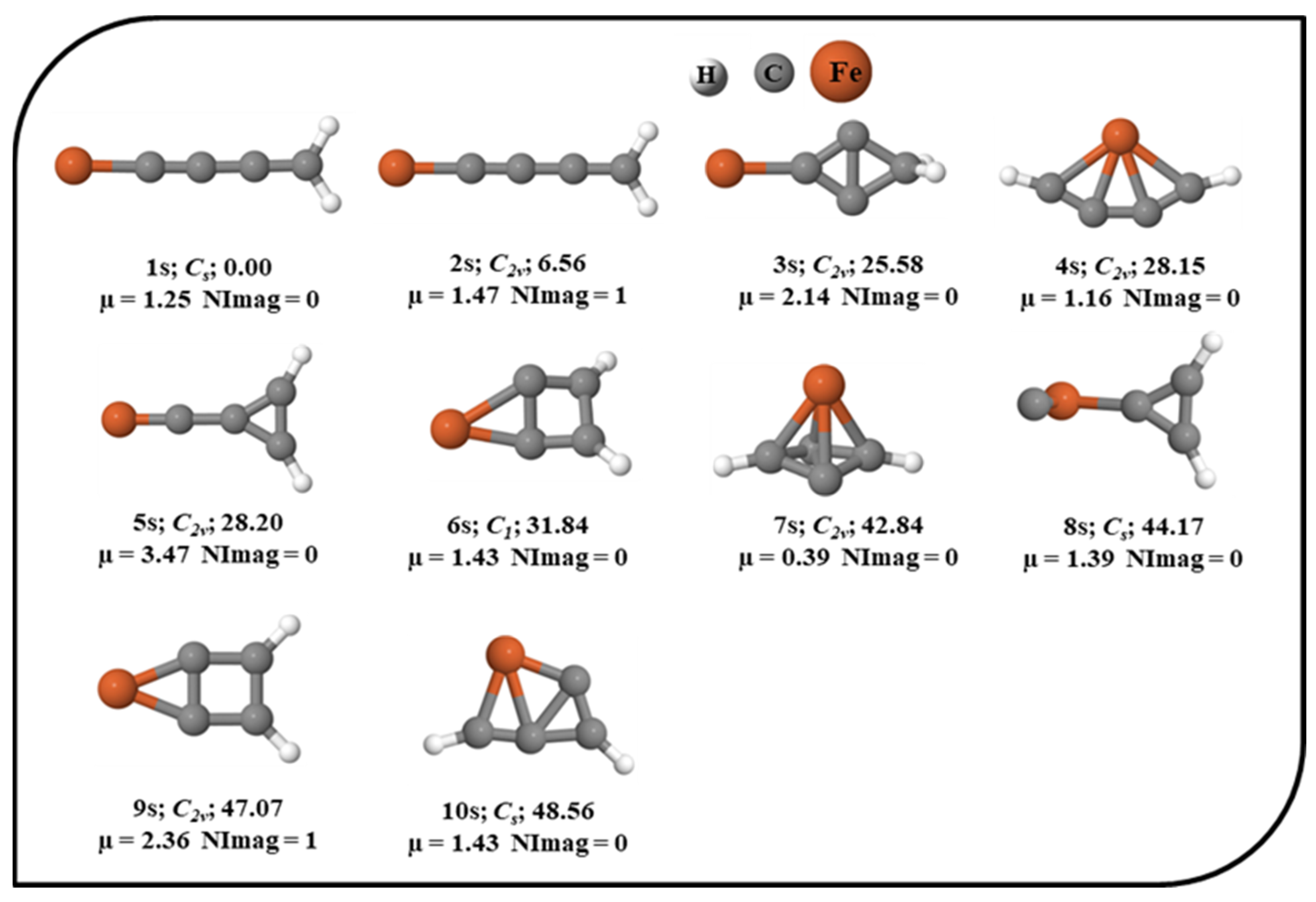
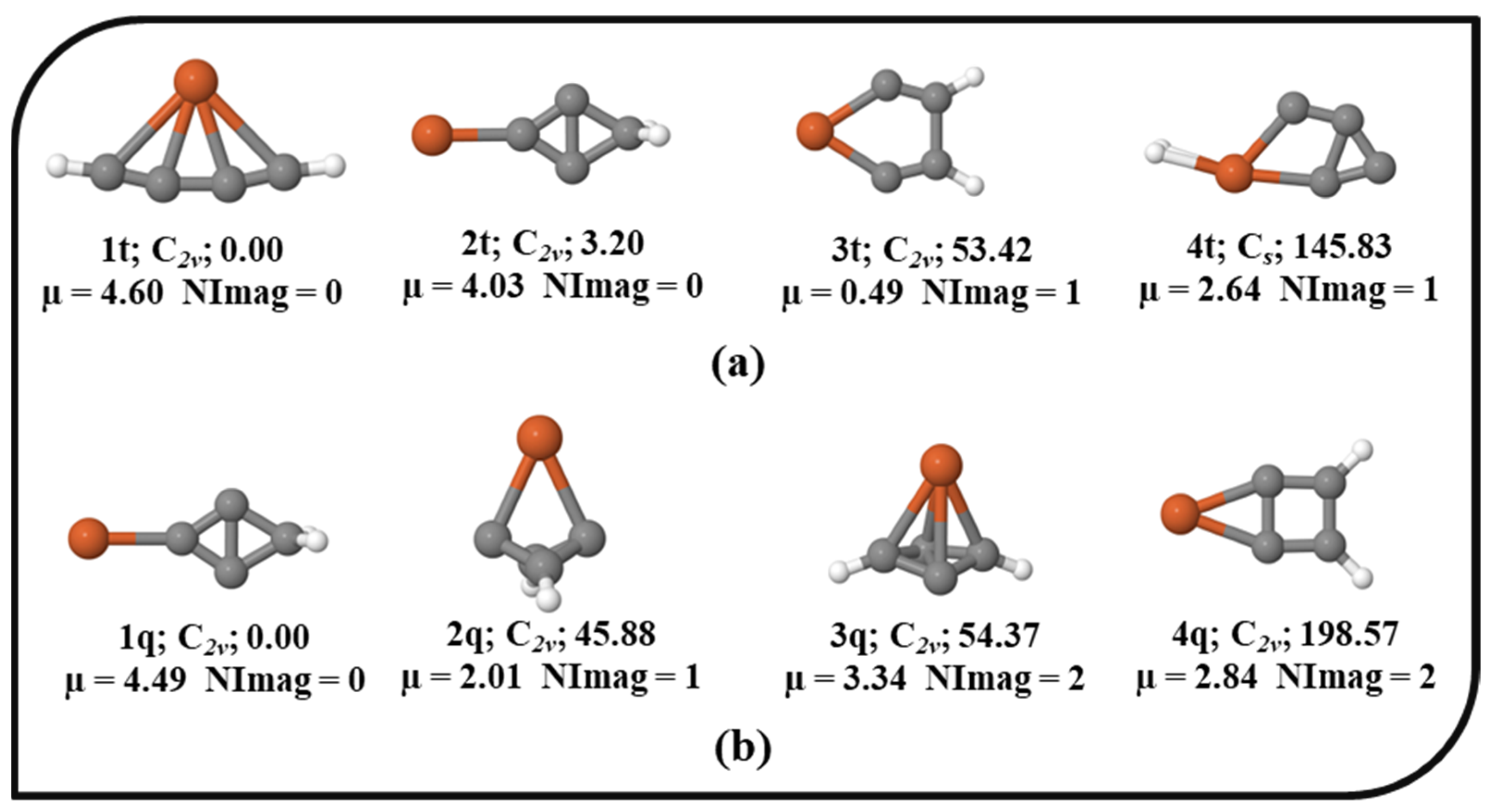
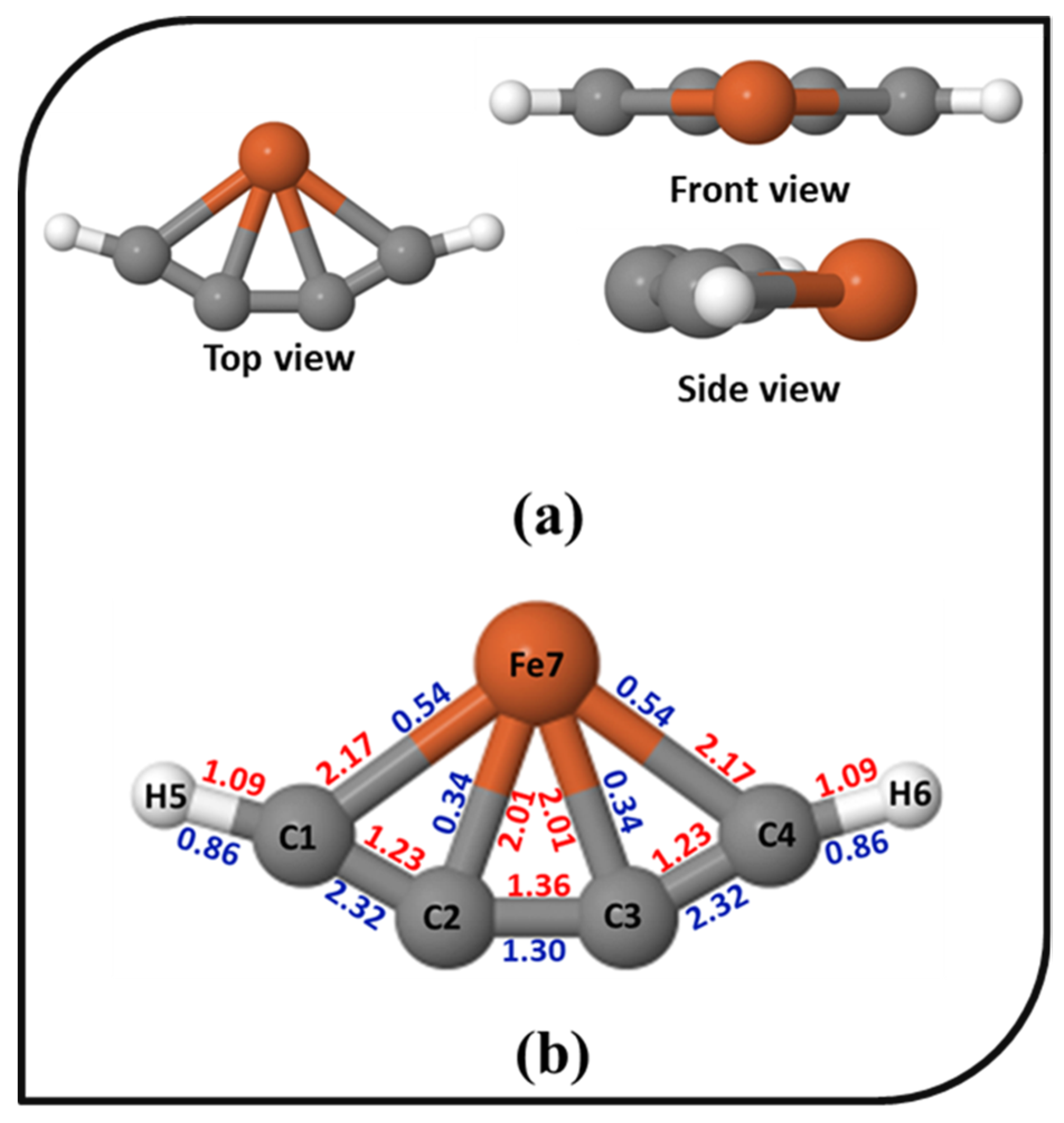
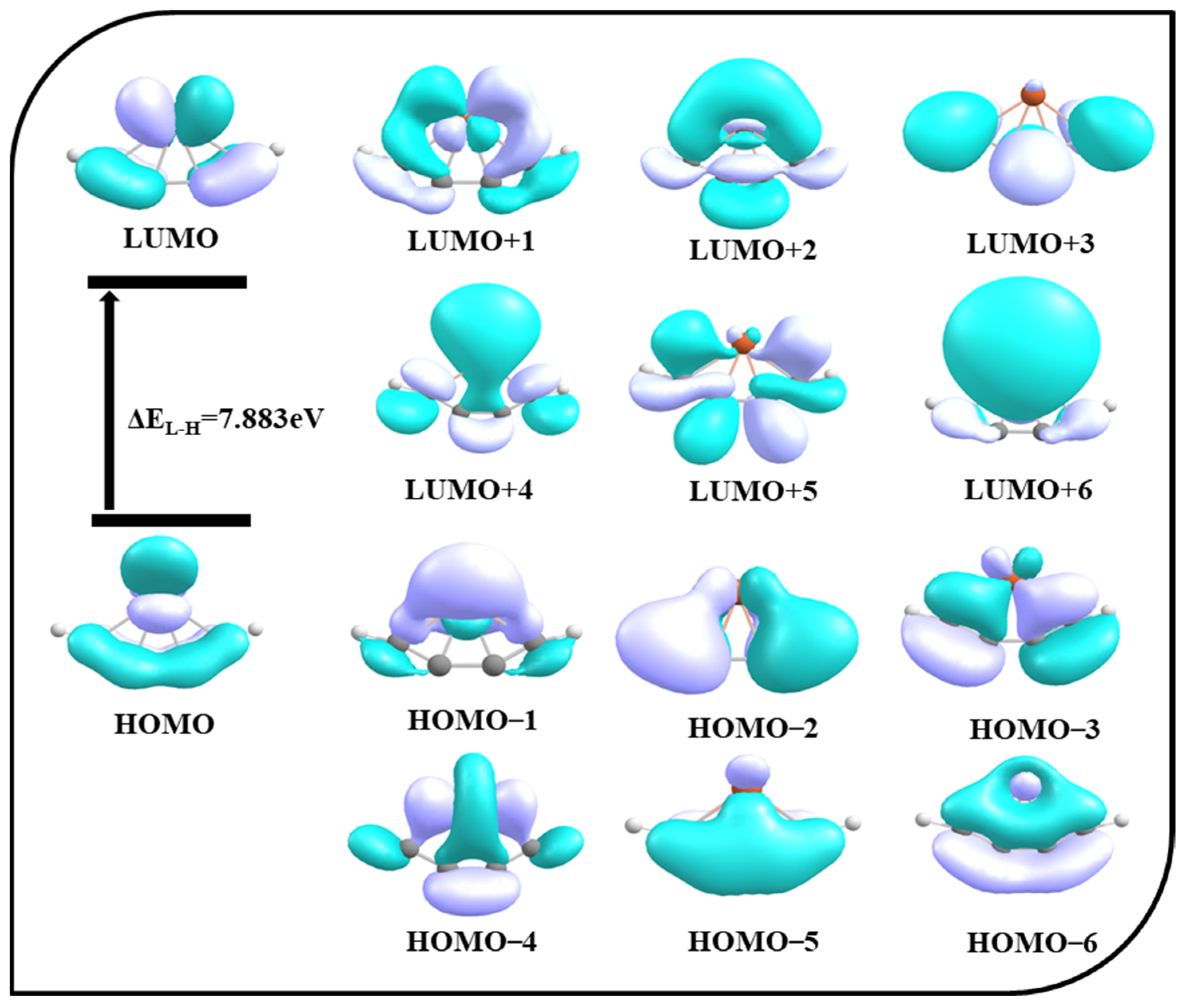
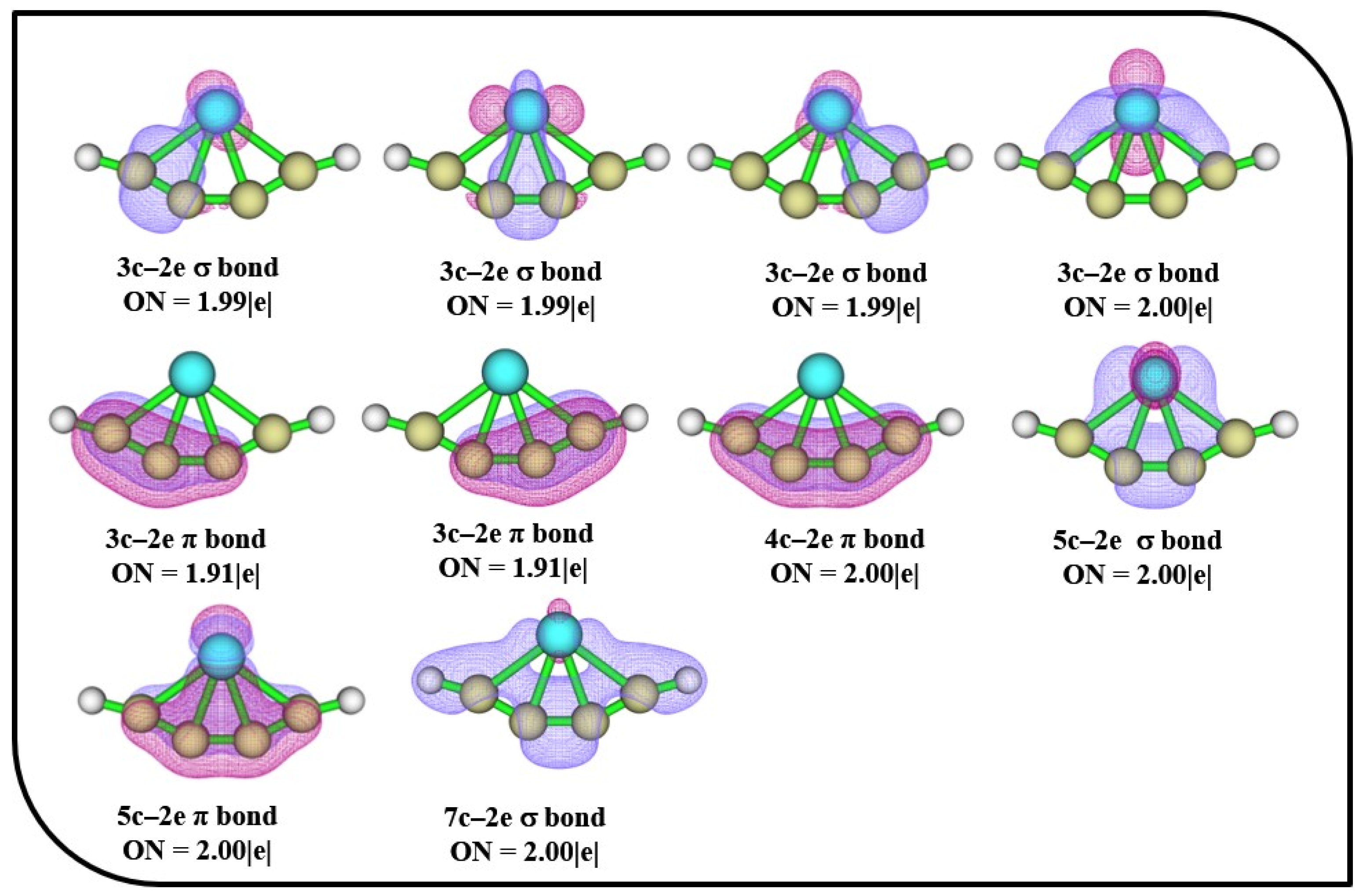
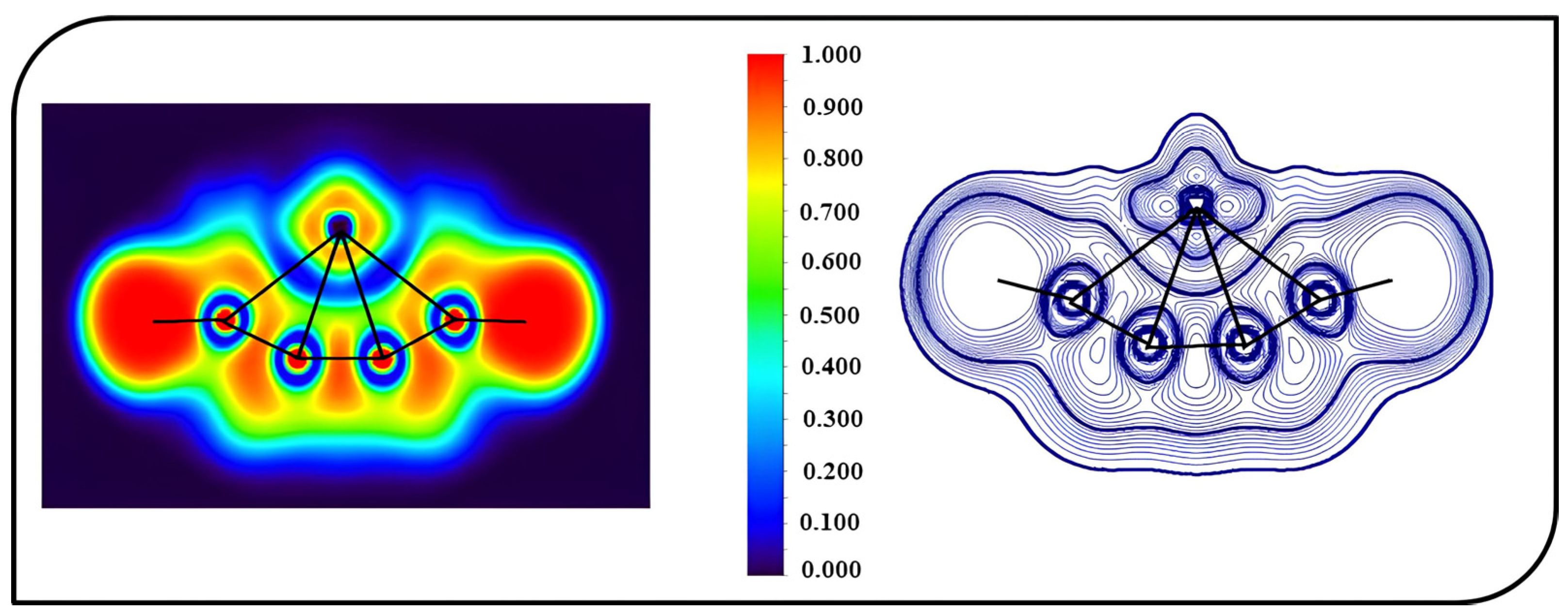
Disclaimer/Publisher’s Note: The statements, opinions and data contained in all publications are solely those of the individual author(s) and contributor(s) and not of MDPI and/or the editor(s). MDPI and/or the editor(s) disclaim responsibility for any injury to people or property resulting from any ideas, methods, instructions or products referred to in the content. |
© 2024 by the authors. Licensee MDPI, Basel, Switzerland. This article is an open access article distributed under the terms and conditions of the Creative Commons Attribution (CC BY) license (https://creativecommons.org/licenses/by/4.0/).
Share and Cite
Shajan, S.; Thirunavukkarsu, K.; Chandrasekaran, V.; Thimmakondu, V.S.; Thirumoorthy, K.
Fe
Shajan S, Thirunavukkarsu K, Chandrasekaran V, Thimmakondu VS, Thirumoorthy K.
Fe
Shajan, Shilpa, Kandasamy Thirunavukkarsu, Vijayanand Chandrasekaran, Venkatesan S. Thimmakondu, and Krishnan Thirumoorthy.
2024. "Fe
Shajan, S., Thirunavukkarsu, K., Chandrasekaran, V., Thimmakondu, V. S., & Thirumoorthy, K.
(2024). Fe






